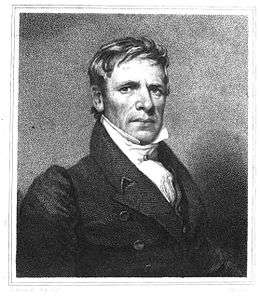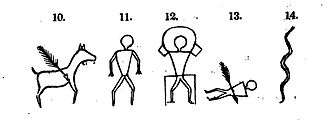John Tanner (captive)
John Tanner (c. 1780 – c. 1846) was captured by Ojibwa Indians as a child after his family had homesteaded on the Ohio River in present-day Kentucky. He grew up with the Ojibwa nation, becoming fully acculturated and learning the Saulteaux language. He married an Indian woman, served as a guide for European fur traders, and worked as an interpreter. His story of life with the American Indians was published in 1830. Titled A Narrative of the Captivity and Adventures of John Tanner..., it was a popular success and remains an important historical record.

Early life
John Tanner was born about 1780. His father, also named John Tanner, was a former preacher from Virginia. The boy’s mother died when he was two and in 1789 the family settled on the Ohio River in Kentucky near the confluence with the Great Miami River.[1] It was considered dangerous country as settlers competed for territory with the local Shawnee Indians who fought to defend their lands.
In 1789 at the age of nine, Tanner was kidnapped by two Ojibwa men and carried north into the Michigan Territory. He was badly mistreated during the first two years of captivity but then was sold to Netnokwa, an Ottawa woman who adopted Tanner and treated him more kindly. She helped him gain the skills he needed to survive and encouraged him in rites of passage such as killing a bear and participating in his first war party. From 1790 to about 1820 Tanner lived with the Ojibwa and Saulteaux in the Great Lakes and Red River regions.[2]
When Tanner lived among these Indians, their traditional life-style as hunters and trappers in the northern forests was beginning to change. The fur trade was drawing the tribes away from subsistence hunting and encouraging fur trapping for profit. Deceitful traders, a shortage of game, and the introduction of firearms and alcohol all had a negative impact on tribes in the region.
In 1800, when he was 20, Tanner married an Ojibwa woman, Mis-kwa-bun-o-kwa, the niece of Michigan fur trader, Madeleine LaFramboise.[3] In 1801 he met a fur trader, Daniel Harmon, who noted in his diary that Tanner spoke only Saulteaux, was regarded as a chief by his people, and was like an Indian in every way except color.[4] Around 1807 his first wife left him and he remarried in 1810 to an Indian woman known as Therezia. During both marriages he quarreled with his in-laws and was threatened with violence. By 1812 he was considering a return to his family in Kentucky but the War of 1812 made travel impossible.[5]
Fur trade and family reunion
In 1812 Thomas Douglas, 5th Earl of Selkirk established a colony in the region on land purchased from the Hudson's Bay Company. Tanner assisted the colonists by hunting bison during their first winter when food was scarce. In 1817, Selkirk employed Tanner as a guide and they set out to recapture Fort Douglas from the English fur trading North West Company. After their success, Lord Selkirk took an interest in Tanner. Using Tanner's vague memories of his childhood, Selkirk located his family in the United States and helped to reunite them. Traveling with his second wife and children, Tanner spent the years 1818-1822 in pursuit of his family. His wife settled on Mackinac Island and their children attended missionary school. Ultimately, the cultural gap proved too big and Tanner gave up hopes of returning to his previous life.[6]
Tanner returned to the Canadian territories, where he worked for a time as a trader with the American Fur Company on Rainy Lake. In 1823 he tried to reclaim his children from his first marriage. His former wife refused to surrender them and persuaded an Indian to try to kill him. Although badly wounded he survived the attack but his children and their mother vanished while he was convalescing.
Life as an interpreter

In 1827, after a lengthy recovery, he settled with his second wife back on Mackinac Island. He worked as an interpreter at a U.S. army outpost. It was here that he met Edwin James, an explorer, botanist, and physician who transcribed Tanner's dramatic story of life among the Ojibwa. Published in 1830, A Narrative of the Captivity and Adventures of John Tanner... was a popular success as well as an important and detailed historical record of the Ojibwa people during a critical period of change. It was later translated into German and French. Tanner also collaborated with Edwards to create an Ojibwa translation of the New Testament.[7][8]
Tanner moved to Sault Ste. Marie in 1828 and began working as an interpreter for the Indian agent, Henry Rowe Schoolcraft. Tanner became involved in a feud between Schoolcraft and Abel Bingham, a Baptist missionary, over control of the local mission school. Eventually, both Schoolcraft and Bingham accused Tanner of siding with the other and betraying their trust.[9]
By 1833 Tanner was unemployed and essentially lived as an outcast on the edge of town for the rest of his life. In 1846 his cabin was burned to the ground and days later he disappeared at the same time Schoolcraft's younger brother, James Schoolcraft, was found murdered. Townspeople quickly suspected that Tanner had killed Schoolcraft but Tanner was never apprehended and his guilt was never proven conclusively. Years later, Tanner's body was uncovered in a bog not far from town.[10]
A grandson of his, also named John Tanner, homesteaded on the Little Saskatchewan River where he ran a ferry. The settlement became known as "Tanner's Crossing". It is the present-day site of Minnedosa, Manitoba.
Notes
References
- Bowsfield, Hartwell (1957). "Meet John Tanner". Manitoba Pageant. Manitoba Historical Society.
- Fierst, John (1986). "Return to "Civilization": John Tanner's Troubled Years at Sault Ste. Marie" (PDF). Minnesota History Magazine. 50 (1): 23–36.
- Sayre, Gordon (2007). "Tanner, John". American National Biography Online. Oxford University Press.
- Woodcock, George (1988). "Tanner, John". Dictionary of Canadian Biography, vol. 7. University of Toronto.
External links
- John Tanner, full text of the Narrative
- John Tanner, full downloadable PDF of the Narrative
- Culpepper, Mike. "John Tanner Between Two Worlds". The Shrine of Dreams.